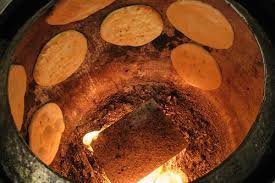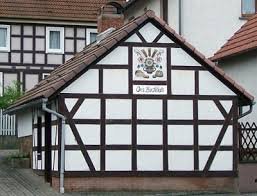Communal Baking
Humans have been using fire to cook food for a long time. Estimates say perhaps as long as 1.5 million years ago. The very first “ovens” were actually fire pits in which food was cooked in the flames, an early method still used in parts of Asia today, and usually protected by banana leaves.
Fire pits are still used for cooking in Hawaii, New Zealand and Africa, although usually for tourists.
Ovens as we know them today have been dated to 29,000 BC. Indian tandoor ovens have been used for generations throughout the Middle East and Asia. A cylindrical oven, the fire sits in the bottom so the heat rises upward. Breads are slapped on to the oven’s side while spicy marinated meat is placed on metal racks in its center.
The ovens of the ancient Greeks were the first front-loaded ovens and it was the Greeks who developed baking into a profession.
The wood fired ovens we use today are close in design to the ones found in the Roman excavations in Pompeii, showing how little they have changed. Like the ancient Greeks, the Romans had professional bakeries in each district as well as an oven in their own homes.
In medieval Europe, the communal bread oven was pivotal to village life for many centuries. Often they were a focal point for the community, with a central location. Once the baker had made the daily village bread, the women of the village would bring their evening meals to bake in the residual heat, no doubt catching up on the daily news and gossip while dinner was cooking.
Conservation work is going on at old, crumbling bakehouses in Germany, Belgium, France and elsewhere. They may be restored to full functioning with baking days and bakery sales, or preserved by conversion into holiday cottages or other private buildings. Or, they may be created because someone in the community found a need and decided to fill it.
It was during my recent trip to Germany that my cousin made me aware of this. In his little town of Freinsheim, 3 traditional bakeries closed because people wanted cheaper bread. Unfortunately, this bread was made by big industry.
My cousin has been a baker for some time now, and has recently started working with sourdough, a natural leavening agent. Sourdough is made with something called a starter, and it’s a bit trickier than simply throwing a packet of instant yeast into some dough. So my cousin started taking classes from a local baker.
Verena Rappaport is this baker.
Here I am, meeting her on my trip.
Verena makes naturally leavened breads. She feeds her sourdough starter and develops the dough Tuesdays - Thursdays. People pre-order the type of loaves they want and she has their bread ready for pickup on Friday afternoons.
Not only does she bake for her community, she purchased a “garden” and with her husband, built a “Backhaus” where she holds classes in baking artisan breads, and sometimes allows members of the community to bring their dough and bake them in her oven. Because of Verena, people in Freinsheim have returned to wanting bread made in the traditional way, without the addition of chemical ingredients, what we’d call “artisan bread” now, which is really just bread the way they used to make it!
Backhaus, Freinsheim. The oven sits under a roof and the garden has apple and fig trees and patio tables. Super cute!
Anything that doesn’t get picked up, or any extras she might have baked, she sells to the public. On the right is her little shop in the heart of their village, just a short walk from the Backhaus. Customers are picking up their orders for the weekend. Sadly, there were no extras for me to buy that day.
I admire Verena for having filled a need in her community by bringing back the idea of the communal oven, creating community around an old idea that she has made new again. Too bad she doesn’t live near me!
You can find her on Facebook at Backhaus Freinsheim.








